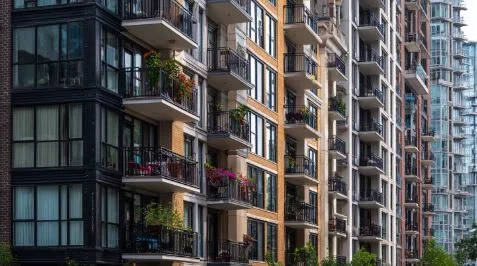Urban Housing Projects Integrate Noise-Reduction Features for Healthier Living
City life has never been louder. Traffic, construction, public transport, and the constant hum of commercial activity create a backdrop that many residents struggle to ignore. For decades, noise was simply accepted as part of urban living. But as research on the health impacts of prolonged exposure to noise has become more widely known, attitudes have shifted.
Urban dwellers are now placing a premium on quiet. Surveys by real estate agencies in several major markets show that buyers and renters are more likely to choose homes advertised as “soundproof” or “acoustically insulated,” even if they come at a higher cost. Developers have taken notice. Many are now building to higher acoustic standards, seeing it not just as a luxury feature, but as an essential selling point.
Developers Adopt Comprehensive Acoustic Standards
Modern urban housing projects rarely rely on a single fix to address noise. Instead, developers are adopting layered solutions that target multiple noise sources. This includes enhanced wall construction, double- or triple-glazed windows, and specialized interior finishes designed to absorb sound. One of the most overlooked, yet highly effective, upgrades involves professional-grade door seals bottom systems. By sealing the gap between the door and the floor, these components prevent noise from traveling between apartments or from hallways into living spaces. They are cost-effective, easy to integrate into new builds, and significantly improve the acoustic performance of a unit.
Industry experts note that small details like this can make a major difference in perceived comfort. While thick walls and upgraded windows block much of the external noise, interior noise—footsteps, conversations, and television sounds—often passes through doors. Effective sealing stops these sounds at one of their most common entry points.
Illustrative Examples of Noise-Reduction Strategies in Residential Projects
Example of a Modern High-Rise in a Dense Urban Area
Imagine a residential tower located just blocks from a busy urban intersection. Day and night, traffic roars past. Sirens, delivery trucks, and honking cars form a near-constant soundtrack. For the residents, peace and quiet could easily feel out of reach.
In projects like this, architects start by designing building envelopes that act as a shield. They specify high-performance windows capable of cutting outside noise by more than half compared to standard glazing. External walls often incorporate multiple layers of dense, sound-dampening materials. Balconies are designed with acoustic barriers to block direct noise paths into living rooms and bedrooms.
Inside, each apartment is treated as its own acoustic bubble. This means adding sound insulation in walls shared with neighbors, isolating plumbing to reduce noise from running water, and fitting entry doors with high-quality seals. These measures combine to create a space where the chaos of the street fades into a distant murmur.
Example of a Mid-Sized Complex in a Mixed-Use Zone
Now consider a mid-sized housing development in a neighborhood where residential buildings share the block with cafes, restaurants, and retail shops. By day, there’s a steady flow of customers and delivery vans. By night, diners and nightlife bring another wave of sound.
Developers working in these environments understand that mixed-use zones require extra care. The ground floor commercial spaces are often isolated from the residential units above through the use of floating floors and heavy-duty ceiling insulation. Interior corridors are designed with sound-absorbing finishes to reduce echoes.
Within individual units, noise control is just as important. Bedrooms, for example, are positioned away from street-facing walls whenever possible. Kitchen and living areas might be placed between sleeping areas and the noise source to act as a buffer. Door systems, windows, and even ventilation pathways are carefully selected for their acoustic performance. While residents can still enjoy the vibrancy of their neighborhood, they can retreat into quiet spaces when they close their doors.
The Link between Acoustic Comfort and Resident Wellbeing
The benefits of noise reduction go far beyond comfort. Research has shown that chronic exposure to high noise levels is linked to increased stress, sleep disturbances, and even cardiovascular problems. For children, noisy environments can impact learning and concentration. For adults, the constant intrusion of unwanted sound can lead to fatigue and reduced productivity.
In contrast, quieter homes support better sleep quality, improved focus, and lower stress levels. This link between acoustic comfort and well-being is driving demand for more advanced noise-reduction features in residential projects. Developers who embrace this priority are finding that it adds measurable value to their properties, both in terms of marketability and resident satisfaction.
The Future of Noise-Reduction in Residential Construction
Looking ahead, industry observers believe acoustic comfort will continue to climb the list of buyer priorities. Urbanization trends show more people moving into densely built areas, where managing noise is a constant challenge. As cities become busier, the demand for homes that offer both connectivity and tranquility will grow.
Developers are already anticipating this shift. Many are integrating acoustic strategies into the earliest design stages of projects rather than treating them as optional add-ons. This proactive approach helps keep costs down and ensures that noise control is baked into the structure itself, not just applied in finishing stages.
Technology is also reshaping what’s possible. New building materials are lighter, thinner, and more effective at blocking sound than their predecessors. Smart building systems can monitor noise levels in real time, alerting property managers to problem areas. These tools not only improve the resident experience but also make it easier for developers to demonstrate value to potential buyers.
Cost Considerations and Return on Investment
One of the reasons acoustic upgrades are gaining momentum is that the economics are improving. Ten years ago, high-performance soundproofing often meant major construction costs. Today, thanks to innovations in manufacturing and installation, many solutions are far more affordable.
For developers, the investment often pays for itself through higher rental rates or sale prices. Real estate agents report that listings highlighting soundproof features tend to attract more attention online and sell faster. In competitive housing markets, even modest acoustic improvements can set a property apart.
Property managers also benefit from reduced maintenance requests and complaints. Noise-related disputes between neighbors are a common source of frustration in multi-family buildings. Reducing those friction points not only improves tenant satisfaction but can also extend lease terms and reduce turnover.
Shifting Regulations and Standards
In some regions, governments are beginning to set stricter noise-control requirements for new construction. These regulations often emerge in response to public health concerns or to protect the character of residential neighborhoods. While the details vary, the general trend is toward higher performance standards.
For developers, this shift means that acoustic upgrades are becoming less about gaining a competitive edge and more about meeting baseline compliance. However, those who go beyond the minimum requirements often see stronger sales results. Buyers and renters are learning to ask about sound ratings and other performance measures before making a commitment.
Regional Differences in Adoption Rates
Not all markets are moving at the same pace. In cities with high population density and significant traffic noise—think New York, London, or Tokyo—acoustic performance is already a high priority. Developers there often treat advanced soundproofing as standard practice.
In contrast, cities with more open space and fewer noise sources may adopt upgrades more slowly. However, even in these markets, certain types of projects—like those near airports, train lines, or entertainment districts—require enhanced noise control from the outset.
Cultural expectations also shape adoption. In some countries, a certain level of background noise is considered normal and even part of urban charm. In others, quiet is closely linked to quality of life, making noise control a stronger selling point.
The Competitive Edge of Quiet
Ultimately, noise reduction is becoming a defining feature of modern urban housing. As buyers and renters grow more aware of its benefits, developers who prioritize acoustic comfort will have a distinct advantage. The projects that stand out in the coming years are likely to be those that balance the energy of the city with the calm of a private retreat.
For residents, the appeal is simple: being able to enjoy the vibrancy of city life without bringing the chaos inside. For developers, it’s an opportunity to meet a rising demand with practical, proven solutions. And for the cities themselves, it’s a step toward healthier, more livable communities.





